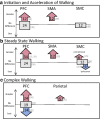Brain activity during real-time walking and with walking interventions after stroke: a systematic review
- PMID: 33451346
- PMCID: PMC7811232
- DOI: 10.1186/s12984-020-00797-w
Brain activity during real-time walking and with walking interventions after stroke: a systematic review
Abstract
Investigations of real-time brain activations during walking have become increasingly important to aid in recovery of walking after a stroke. Individual brain activation patterns can be a valuable biomarker of neuroplasticity during the rehabilitation process and can result in improved personalized medicine for rehabilitation. The purpose of this systematic review is to explore the brain activation characteristics during walking post-stroke by determining: (1) if different components of gait (i.e., initiation/acceleration, steady-state, complex) result in different brain activations, (2) whether brain activations differ from healthy individuals. Six databases were searched resulting in 22 studies. Initiation/acceleration showed bilateral activation in frontal areas; steady-state and complex walking showed broad activations with the majority exploring and finding increases in frontal regions and some studies also showing increases in parietal activation. Asymmetrical activations were often related to performance asymmetry and were more common in studies with slower gait speed. Hyperactivations and asymmetrical activations commonly decreased with walking interventions and as walking performance improved. Hyperactivations often persisted in individuals who had experienced severe strokes. Only a third of the studies included comparisons to a healthy group: individuals post-stroke employed greater brain activation compared to young adults, while comparisons to older adults were less clear and limited. Current literature suggests some indicators of walking recovery however future studies investigating more brain regions and comparisons with healthy age-matched adults are needed to further understand the effect of stroke on walking-related brain activation.
Keywords: Brain imaging; EEG; FDG-PET; Gait; Rehabilitation; Stroke; fNIRS.
Conflict of interest statement
No authors have any conflicts to declare.
Figures



Similar articles
-
Analysis of stroke patient walking dynamics using a tri-axial accelerometer.Gait Posture. 2009 Jul;30(1):60-4. doi: 10.1016/j.gaitpost.2009.02.017. Epub 2009 Apr 5. Gait Posture. 2009. PMID: 19349181
-
Stepping strategies used by post-stroke individuals to maintain margins of stability during walking.Clin Biomech (Bristol). 2013 Nov-Dec;28(9-10):1041-8. doi: 10.1016/j.clinbiomech.2013.10.010. Epub 2013 Oct 22. Clin Biomech (Bristol). 2013. PMID: 24200373 Clinical Trial.
-
Markedly impaired bilateral coordination of gait in post-stroke patients: Is this deficit distinct from asymmetry? A cohort study.J Neuroeng Rehabil. 2011 May 5;8:23. doi: 10.1186/1743-0003-8-23. J Neuroeng Rehabil. 2011. PMID: 21545703 Free PMC article.
-
Gait post-stroke: Pathophysiology and rehabilitation strategies.Neurophysiol Clin. 2015 Nov;45(4-5):335-55. doi: 10.1016/j.neucli.2015.09.005. Epub 2015 Nov 4. Neurophysiol Clin. 2015. PMID: 26547547 Review.
-
Paretic propulsion as a measure of walking performance and functional motor recovery post-stroke: A review.Gait Posture. 2019 Feb;68:6-14. doi: 10.1016/j.gaitpost.2018.10.027. Epub 2018 Oct 25. Gait Posture. 2019. PMID: 30408710 Free PMC article. Review.
Cited by
-
Frontal, Sensorimotor, and Posterior Parietal Regions Are Involved in Dual-Task Walking After Stroke.Front Neurol. 2022 Jun 22;13:904145. doi: 10.3389/fneur.2022.904145. eCollection 2022. Front Neurol. 2022. PMID: 35812105 Free PMC article.
-
Premotor and Posterior Parietal Cortex Activity is Increased for Slow, as well as Fast Walking Poststroke: An fNIRS Study.Neural Plast. 2023 Oct 13;2023:2403175. doi: 10.1155/2023/2403175. eCollection 2023. Neural Plast. 2023. PMID: 37868191 Free PMC article.
-
Targeting CNS Neural Mechanisms of Gait in Stroke Neurorehabilitation.Brain Sci. 2022 Aug 9;12(8):1055. doi: 10.3390/brainsci12081055. Brain Sci. 2022. PMID: 36009118 Free PMC article.
-
Modifications in Prefrontal Cortex Oxygenation in Linear and Curvilinear Dual Task Walking: A Combined fNIRS and IMUs Study.Sensors (Basel). 2021 Sep 14;21(18):6159. doi: 10.3390/s21186159. Sensors (Basel). 2021. PMID: 34577366 Free PMC article.
-
Brain activation of the PFC during dual-task walking in stroke patients: A systematic review and meta-analysis of functional near-infrared spectroscopy studies.Front Neurosci. 2023 Feb 16;17:1111274. doi: 10.3389/fnins.2023.1111274. eCollection 2023. Front Neurosci. 2023. PMID: 36875661 Free PMC article.
References
Publication types
MeSH terms
Grants and funding
LinkOut - more resources
Full Text Sources
Other Literature Sources
Medical

